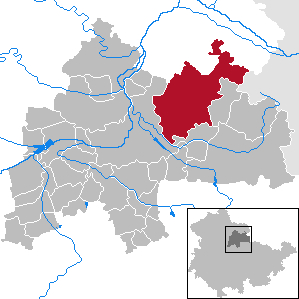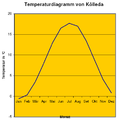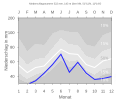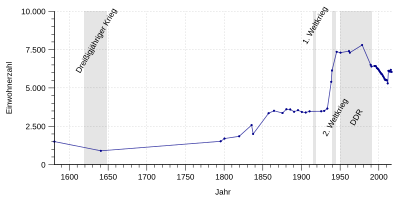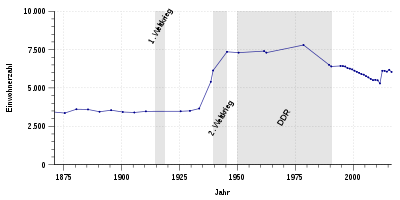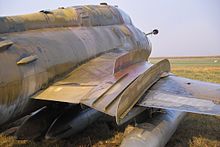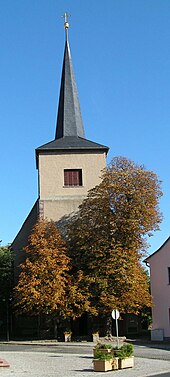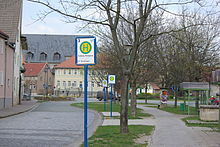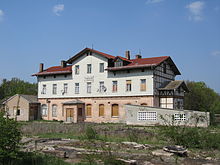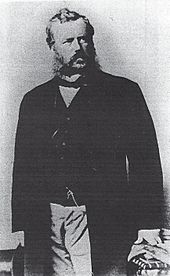Koelleda
| coat of arms | Germany map | |
|---|---|---|

|
Coordinates: 51 ° 11 ′ N , 11 ° 15 ′ E |
|
| Basic data | ||
| State : | Thuringia | |
| County : | Sömmerda | |
| Management Community : | Koelleda | |
| Height : | 145 m above sea level NHN | |
| Area : | 89.52 km 2 | |
| Residents: | 6348 (Dec. 31, 2019) | |
| Population density : | 71 inhabitants per km 2 | |
| Postal code : | 99625 | |
| Primaries : | 03634 ( Sömmerda local network ) 03635 (Kölleda local network) | |
| License plate : | SÖM | |
| Community key : | 16 0 68 034 | |
| LOCODE : | DE KLD | |
| City structure: | 9 districts | |
City administration address : |
Markt 1 99625 Kölleda |
|
| Website : | ||
| Mayor : | Lutz Riedel ( SPD ) | |
| Location of the city of Kölleda in the Sömmerda district | ||
Kölleda (until 1927 Cölleda ) is a rural small town in Thuringia . The municipality belongs to the district of Sömmerda and is located about ten kilometers east of the district town of Sömmerda on the edge of the Thuringian basin . With about 6300 inhabitants, it is the third largest municipality in the district and the seat of the Kölleda administrative community . The inhabitants are called "Kölledaer".
Kölleda acts as a sub-center for the region . The city is characterized by the traditional large-scale cultivation of medicinal and aromatic herbs, especially peppermint . This led to the nickname “Peppermint City” and “Peppermint Railway ” for the Straussfurt – Großheringen railway line that ran past .
Kölleda has an eventful 1200 years of history. Important for the city development was during the time NS construction of airfield and air Zeugamt for the Air Force and later the communist era of VEB Funkwerk Kölleda (now Funkwerk AG ). After the Second World War , this was founded as the “Neutrowerk” by committed returning and drafted experts - after the most difficult negotiations with the Soviet military administration - in the “old building” of the air base, which was therefore not blown up. There are many small and medium-sized companies in Kölleda. In particular, electrical engineering and metal processing have become increasingly important as economic factors for the city.
The "Jahnstadt" Kölleda is also known as the place of exile for the "gymnastics father" Friedrich Ludwig Jahn (memorial plaque east of the Roßplatz crossing; around 1960 also with "Jahnsportspiele" and today again with Jahnplatz) and as the birthplace of the chemist Fritz Hofmann , inventor of the artificial methyl rubber (Buna rubber), with the house where he was born (memorial plaque) in the former Auenstrasse, which was renamed after him.
geography
Kölleda lies at an altitude of about 145 m above sea level and is centrally located in the black earth area in the north-eastern Thuringian Basin . In the immediate vicinity, the wooded ridges of Finn and Schmücke extend east and north of the city. The urban area covers an area of 31.28 square kilometers. The city is ten kilometers east of Sömmerda and 24 kilometers north of Weimar .
Neighboring communities
Kölleda borders on the following communities (clockwise, starting from the north): Sömmerda , An der Schmücke , Oberheldrungen , Roßleben-Wiehe , Ostramondra and Großneuhausen .
geology
The Thuringian Basin, in which Kölleda is located, belongs geologically to the Triassic period, in which horizontal layers of red sandstone , shell limestone and Keuper were deposited. Underneath there are salt and gypsum deposits from the Zechstein .
City structure
In addition to the core city, Kölleda has seven districts: Altenbeichlingen , Backleben , Battgendorf , Beichlingen , Burgwend , Dermsdorf , Kiebitzhöhe and Großmonra .
climate
The climate of Kölleda can be described as the climate of a "temperate Provence " with little rain and a lot of sun. The city is one of the places with the lowest rainfall in Germany. Although Kölleda is in a deeply warming depression, monthly average temperatures of over 21 ° C are not reached there. The average rainfall per year is around 469 mm.
history
First mention and origin of the name
Kölleda was first mentioned in the year 786 as the village of Collide in the Hersfeld Monastery , the Breviarium Sancti Lulli . The ending of the place name is a connection between the Old High German -idi and the Old Saxon -ithi . The interpretation of the place name is difficult. The general opinion is that collide means something like "in swampy terrain". This name interpretation is probably correct due to the location of the place in the geological area of the Thuringian Basin. The basic word is unlikely to be derived from the caulis for cabbage, which was borrowed from the Latin language , as was previously speculated , since the vowel in the place name Collide was probably short before the double-l. Short vowels, on the other hand, are included in the Old and Middle High German words kolo and kol for coal / charcoal and Alemannic cholle (n) for glimmer / glow. Other opinions therefore assume that Collide referred to a place where charcoal was made, i.e. a charcoal kiln. Since Kölleda was not in a forest area, there are other interpretations in research, e.g. B. a place of cultivation for Pfefferkraut ( Kölle ), i.e. peppermint, which is still grown here today.
Over the centuries the place name changed to the "Cölleda", which is still in use today. Since 1927 the city name has been officially spelled with "K", ie "Kölleda" instead of "Cölleda".
The nickname "Kuhkölln" is also popularly used. This place name appears in an old file in 1487, which, according to a legend which the chronicler Friedrich Heinrich Grüning wrote down in 1833, is said to have the following origin:
“A noble gentleman once wanted to travel through the city, and when he came through the gate, he met a very large number of cattle, which were driven to the beautiful pastures belonging to the city. Since he now had to wait a long time in front of the gate to let the cattle coming in a long line past him, he asked what the place was called. They tell him his name is Cölln. 'Oh', says the strange gentleman, 'one would like to call it Kuhcölln, unlike other cities, because the inhabitants can keep such a large herd of cattle.' "
An interpretation with the derivation of the hoods of the nuns of the local monastery, the Kukelen, is also credible. Even today, the population still uses the nickname, especially at the annual carnival parade with "Kuhkölln - Helau".
Historical spellings of the name Kölleda
| Notation | Mention in documents |
|---|---|
| Collide | in 786 |
| Collithi | in the years 1005-1012 |
| Colleda | in 1044 |
| Kulide | in 1195 |
| Kolleda | in 1224 |
| Culleda | in 1229 |
| Cow litter | in 1478 |
| Colleda | Late 15th century |
| Colde | in 1519 |
| Cologne on the Lossa | in the 16th century |
| Cölleda | until 1927 |
| Koelleda | from 1927 |
middle Ages
The town's feudal lord was the Hersfeld Monastery , which enfeoffed the Counts of Beichlingen with income from the town . When the Peter and Paul Church in the village slowly became too small for the growing population, the St. Johannes Monastery Church was built in its place in 1266. The church was part of the monastery of the nunnery of the gray Order of St. Benedict founded on September 8th at the instigation of Abbot Lullus of the Hersfeld Monastery . In 1303 numerous Jews in Cölleda and the surrounding area were murdered because of their religion. Cölleda developed at the intersection of two trade routes as a market and trade center to the most important place in the area, which led to Friedrich VI. Count von Beichlingen awarded Cölleda town charter in 1392. Despite town charter, however, the supreme suzerainty remained with the Hersfeld Monastery. At the beginning of the 16th century, the Lords of Werthern took the place of the Counts of Beichling. Your family coat of arms was included in the city arms of Cölleda.
Modern times and industrialization
In a plague-like epidemic, 500 people died in Cölleda in 1518. In 1519 the Counts of Werthern received the county of Beichlingen and the rights to the municipality of Cölleda. With the boom in agriculture and cattle breeding in the area, a distinctive market system developed, which led to a market fountain being built in 1528. After the Schmalkaldic War , Cölleda was part of the Electorate of Saxony . The Backleber Gate was built in 1553 and the Bridge Gate three years later. With the dissolution of the Hersfeld Monastery, the city acquired the land belonging to it. The plague fell 448 people to the opera in 1577 and 1578. During the Thirty Years War (1618–1648) there were repeated military activities, looting and epidemics in the city. 1000 people died in Kölleda in the plague in 1626. In 1634, troops from the Electorate of Saxony came to stand quarters in Cölleda for 22 weeks. Cölleda had to pay a monthly contribution of 800 thaler. To commemorate peace after the war, a memorial stone was erected on April 19, 1649 along the boundary between Cölleda and Großneuhausen.
In addition to the two existing town halls, the third town hall was built in 1702. In 1724 the Electoral Saxon Post Office was built and in 1744 the new school on the market. After the Congress of Vienna in 1815, Prussia received some Albertine lands, including Cölleda. With the relocation of the district office from Wiehe to Cölleda in 1824, Cölleda was raised to the district seat of the newly established district of Eckartsberga in the administrative district of Merseburg in the province of Saxony by royal cabinet order. The year 1824 also marked the beginning of the cultivation of medicinal herbs, especially peppermint , which gave Cölleda the nickname of peppermint town in 1830 . During the March Revolution in 1848, civil defense units prevailed over the Prussian military and forced the soldiers to withdraw from the city. On September 22nd of the year there was a people's assembly in Cölleda, in which 15,000 people from Cölleda, Sömmerda and the surrounding villages are said to have participated. This meeting was an expression of a popular movement that had forced the expropriation of the large estates in two neighboring communities of Sömmerdas and their distribution among the peasants and day laborers. The movement was put down, however, and one of its leaders and 70 other people from the region were each sentenced to 25 years in prison. In 1857 the Kreissparkasse was established. The Saal-Unstrut-Eisenbahn-Gesellschaft (SUE), founded in Cölleda in 1870, opened the Straussfurt – Großheringen ("Pfefferminzbahn") railway in 1874 ; this gave Cölleda a telegraph post . Seven years after the railway line went into operation, stagecoaches ceased in 1881 . In 1884 the district office ( district office ) was built. The fountain was connected to the newly built water pipe from the Backleber spring in 1890.
At the turn of the century in 1900 a gas works was built in Cölleda, the new school in Hundtgasse was handed over and the first telephone connection was put into operation. In 1908 a hospital was built. The handover of the children's home, which had been built with funds from the Karl and Fritz Feistkorn Foundation, took place in 1911. On March 12, 1912, the construction contracts for the Laucha – Kölleda ( Finnebahn ) railway were awarded. In 1913 the public bath tub was handed over by the Feistkorn Foundation.
On May 1, 1914, the Cölleda – Lossa section of the Finnebahn opened. With the construction of the Finnebahn, Cölleda became a railway junction. At the end of the First World War (1914-1918) Cölleda counted more than 100 dead.
The electrification of Cölleda began in 1924. Due to the morphologically more appropriate initials , the spelling was changed to Kölleda in 1927.
From National Socialism to the founding of the GDR
On January 1, 1934, the Prussian Municipal Constitutional Act of December 15, 1933 was introduced, the municipality of Kölleda was renamed the City of Kölleda. During the Nazi era, Kölleda experienced strong population growth, due to the rearmament policy of the 1930s. In 1935, an air base and an air station office were built in Kölleda, which represented a turning point in urban development, because within a few years the number of inhabitants had almost doubled in connection with the air base and the necessary technical flight personnel. In 1936 the Schillingstedter Siedlung and the Bahnersiedlung were built, the barracks were built on the Kiebitzhöhe and the Kiebitzhöhe received a railway stop. At the same time, the airfield was expanded into one of the largest air force bases in Germany. On November 1, 1941, Auenstrasse was renamed Prof.-Hofmann-Strasse on the occasion of Fritz Hofmann's 75th birthday .
Shortly after the seizure of power of the Nazis established a strong persecution of Jews, Social Democrats, Communists and members of the professing church one, several citizens of Kölleda were deported to concentration camps. Another citizen was sentenced to imprisonment in 1943 for " insidious statements", which he served in the Erfurt prison. A woman who had been protected by her non-Jewish husband until then was deported to the Theresienstadt concentration camp in 1944 , where she died two days after her arrival. During the Second World War , a large number of prisoners of war as well as women and men from Belgium , France , the Netherlands and the Soviet Union had to do forced labor : on the air base and on the Angora farm . On the instructions of the SED state leadership, the war memorial on Rossplatz was redesigned into a memorial for the victims of fascism in 1946/47 .
Despite an air raid on the airfield in Kölleda in 1944, the city center was spared during World War II and was handed over to the Americans on April 11, 1945 without a fight. On July 1, the American occupation was replaced by the Soviet.
Immediately after the takeover, the Soviet Army set up a prison in the villa on the corner of Bahnhofstrasse and Hopfendamm. The prison was operated by the Soviet secret service. There were various reasons for imprisonment, such as the mistreatment of Eastern workers, activity in National Socialist organizations, possession of weapons and activity as werewolf . Some of the prisoners were also mistreated during interrogation and some were subsequently sentenced by the military tribunal in Naumburg to 10 or 25 years of prison labor. There were also sentences to death, the executions took place in the Rote Ochsen in Halle . The other convicts came via Halle to Torgau Fortress (Fort Zinna) or to Bautzen . At the end of 1947 the prisoners were taken to the Soviet special camp in Sachsenhausen . A prime example is the story of the Greussener boys .
At the beginning of 1948 the Finnebahn was shut down in favor of reparation payments for the Soviet Union .
GDR time
On October 7, 1949, Kölleda became part of the newly founded German Democratic Republic . In 1950 the government of Saxony-Anhalt decided to rename the Eckartsberga district to Kölleda district. Battgendorf was incorporated on July 1, 1950. Due to the territorial reform in 1952, Kölleda lost its district town status and has since been part of the Sömmerda district ( Erfurt district until 1990 , Thuringia since then). In 1957 the municipal swimming pool at the Streitsee was handed over. The Kiebitzhöhe was built as a new district in the east of the city in 1958. A bus station was built in 1968 on Rossplatz. In 1978 the community association was founded. The 1200 year celebration took place in 1986. In 1990, Kölleda hosted games for the 1990 European Under-16 Football Championship .
Post-turnaround time
In 1992 the residential area Feistkornstrasse with 212 apartments was handed over. In the same year, the citizens of Kölleda and their guests celebrated the 600th anniversary of the granting of town and market rights by Count Friedrich VI. from Beichlingen. A year later the city library and the city archive were inaugurated in the former bath tub. The administrative association Kölleda was founded in 1994. The municipalities of Beichlingen, Großmonra, Großneuhausen, Kleinneuhausen, Ostramondra and Schillingstedt now belonged to the administrative community. In the same year, the local history museum on Rossplatz was reopened after a reconstruction. Dermsdorf was incorporated on January 22nd by the Thuringian Reorganization Act of August 27, 1993. In 1997 the topping-out ceremony for the school extension was held at the Prof. Hofmann Gymnasium. The herb mill was inaugurated in 1998. In a record attempt in 1999, Kölleda was able to enter the Guinness Book of Records with the largest tea bag in the world .
In 1999 the city sought to end its membership in the administrative community of Kölleda , which had existed since 1994 , because this violated its local self-government rights. Since this was not possible according to Sections 25 and 48 sentence 1 of the Thuringian Community Restructuring Act, she lodged a constitutional complaint with the Thuringian Constitutional Court. However, the Constitutional Court rejected the constitutional complaint with a judgment of July 30, 1999.
At the turn of the millennium in 2000, the Funkwerkmuseum Kölleda was handed over. In 2001 the exhibition Against Forgetting - Air War History of Central Germany was opened in the Backleber Tor.
When a location was sought for the MDC Power GmbH engine plant , Kölleda was selected from among 49 possible locations. As a result, large investments in infrastructure were made in the industrial park. The industrial track up to the Kiebitzhöhe industrial area was relocated and a roundabout was created between Frohndorf and Kölleda in order to direct heavy goods traffic from federal highway 176 over the new cross road to the industrial area. Construction of the engine plant began in 2002 and the topping-out ceremony took place on August 2nd. On December 11th of that year, a new substation was put into operation for the industrial area, and five days later, on December 16th, the new connection from the roundabout to the industrial area Kiebitzhöhe and the section of the federal highway 71 from Sömmerda to Erfurt were inaugurated. The construction was completed in December 2003 and production started on December 4th. After more than a year of testing, the Thuringian Ministry of the Interior decided in 2006 to allow the city of Rastenberg to join the Kölleda administrative community. With effect from January 1, 2007, the city of Rastenberg joined the Kölleda administrative community. On December 31, 2012, the municipality of Großmonra with its districts of Backleben and Burgwend was incorporated into Kölleda. On January 1, 2019, the municipality of Beichlingen was incorporated with the districts of Beichlingen and Altenbeichlingen .
Religions
The majority of the city's devout residents are Protestants. The Protestant regional parish of Kölleda is looked after by the pastors Gerlinde and Joachim Justus Breithaupt. You are responsible for the places Kölleda, Ostramondra, Großmonra, Backleben, Burgwend, Battgendorf, Backleben, Dermsdorf, Bachra / Schafau and Ostramondra. There are regular Christian teaching and confirmation classes. A community center was officially opened in Kölleda in 2014. The “Colored Unit” gospel choir rehearses here.
Population development
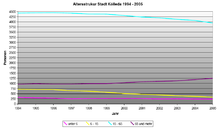
The following data and graphics show the population development and the age structure of the city of Kölleda. In summary, one can see that the population development increased sharply during the time of National Socialism and the GDR. This is due on the one hand to the former air base and the Aircraft Office and on the other hand to the radio works, both of which were major employers in the city. As a result of the Thirty Years' War, there has been a sharp decline in population. After the fall of the Wall (GDR) there was a steady decline in the number of inhabitants until Großmonra was incorporated in 2012. The age structure of the city shows a demographic change towards an increasingly older society.
Development of the population before 1990
|
|
|
Development of the population from 1990
|
|
|
from 1994: source is
politics
City council
The council has 20 seats and one vote of the mayor by virtue of his office.
| Political party | Voices 1999 |
Seats 1999-2004 |
Voices 2004 |
Seats 2004-2009 |
Voices 2009 |
Seats 2009-2014 |
Voices 2014 |
Seats 2014-2019 |
|---|---|---|---|---|---|---|---|---|
| CDU | 40.6% | 8th | 55.9% | 12 | 44.7% | 9 | 27.5% | 6th |
| The left | 14.3% | 3 | 18.4% | 4th | 17.6% | 3 | 9.9% | 2 |
| Citizens' Initiative Kölleda e. V. | 19.4% | 4th | 10.4% | 2 | 14.8% | 3 | 12.3% | 2 |
| Free voters | - | - | - | - | - | - | 33.9% | 7th |
| SPD | 14.9% | 3 | 11.9% | 2 | 13.4% | 3 | 11.1% | 2 |
| FDP | 10.8% | 2 | 3.4% | 0 | 9.4% | 2 | 2.4% | 0 |
| NPD | - | - | - | - | - | - | 3.0% | 1 |
City council elections
In the 2014 city council elections in Kölleda there were 5,230 people entitled to vote, 2,973 citizens exercised their right to vote, which corresponds to a voter turnout of 56.8% (2009: 48.3%, 2004: 46.5%, 1999: 56.7%) . Of the votes cast, 104 were invalid. The relative distribution of votes is shown in the table. As in the mayoral elections in 2012, the free voters prevailed in the city council elections and won 7 seats. This replaced the CDU as the dominant party, which had to give up 3 seats and suffer losses of 17.2%. The same applies to Die Linke , which suffered a loss of 7.7% and, like the SPD, lost a seat. The FDP failed due to massive losses (−7.0%) on the threshold clause and was thrown out of the city council. The municipal citizens' initiative Kölleda also lost a seat, but forms a coalition with the Free Voters, which with 9 seats does not have a majority. In addition to the free voters, the NPD also moved into the city council. With 3.0% it just overcame the threshold clause and was given a seat. Neither party stood in the 2009 city council election. Mayor Frank Zweimann , who had left office two years earlier, also ran for the elections and won a seat.
mayor
Since the granting of city rights in 1392, the most important right of the Kölledaer citizens was to elect a twelve-member council, headed by the “councilor”, who soon carried the title of “mayor”. In the 16th and 17th centuries, the top of the city consisted of "three agents", a ruling and two dormant mayors, only one of whom was in charge at a time. The mayors were employed part-time until 1832. The mayor's office in Kölleda has only been run full-time since the revised Prussian town order was introduced in 1831.
Udo Hoffmann (Free Voters), who was elected in the mayoral ballot on May 6, 2012, has been the full-time mayor of Kölleda since July 1, 2012. For reasons of age, he was not allowed to run again in the local elections on April 15, 2018. In a runoff election on April 29, 2018, Lutz Riedel (SPD) prevailed against Patric Nowak, who has held the mayor's office since July 1, 2018.
- Previous mayor of the city of Kölleda
| Period | Surname | Political party |
|---|---|---|
| since 2018 | Lutz Riedel | SPD |
| 2012-2018 | Udo Hoffmann | Free voters |
| 1992-2012 | Frank Zweimann | CDU |
| 1990-1992 | Bernd Prellberg | FDP |
| 1983-1990 | Helmut Zirnik | SED / PDS / non-party |
| 1982-1983 | Heinz Wurzler | SED |
| 1980-1982 | Manfred Hölzer | SED |
| 1973-1980 | Kurt Hoffmann | SED |
| 1955-1973 | Hans Helm | SED |
| 1952-1954 | Josef Ommer | |
| 1951-1952 | Ida Ragnitz | |
| 1949-1950 | Kurt Kortsch | |
| 1947-1948 | Kurt Koch | |
| 1946-1947 | Kurt Kortsch | |
| July 1, 1945–1946 | Otto Paehlke | |
| March 28, 1945–? | Carl Steinicke | NSDAP |
| 1933-27.3.1945 | Pinger | NSDAP |
| 1909-1933 | Otto Graupner | |
| 1888-1909 | Dance | |
| 1849-1876 | Albert Gottlöber | |
| 1843-1849 | Albrecht | |
| 1832-1843 | Karl Wilhelm Kirchheim | |
| 1825–1832 (?) | Christian Hermann Haubold | |
| 1816-1825 | Christoph Günther Graf | |
| 1798-1816 | Christian Lehmann | |
| ? -1798 | Johann Heinrich Döring | |
| ? | Simon Wettig |
coat of arms
St. Wippertus , patron saint of the city, is depicted on the coat of arms of Kölleda . St. Wippertus is on a silver background, facing to the right, holding grapes in his right hand and a golden staff in his left hand. Under St. Wippertus there is a heraldic shield depicting a golden branch of an oak tree with three leaves on a black background.
Meaning: St. Wippertus was a Benedictine monk from the Anglo-Saxon monastery of Glastonbury and a pupil of Boniface . Around 730 he came to the Hessian-Thuringian mission area. The grapes in St. Wippertus' hand are related to a miracle story. Then one day the necessary mass wine was missing. St. Wippertus, however, brought a freshly picked grape, pressed its juice with his hands into the communion chalice and had fermented wine in it. The coat of arms with the oak leaves is the coat of arms of the Counts von Werthern, who obtained the rights to the city in 1519.
City friendship
- Hochheim am Main in Hesse
Culture and sights
Museums
The Heimatmuseum Kölleda deals with the history of Kölleda. It originated in one room in the town hall and two rooms in the old school. It was built in 1901 by Bruno Schwabe. He brought together the first pieces in memory of Kölleda and the surrounding area, war memories of the district war club and scientific objects. In 1942 the museum moved to the Schwab'sche garden house.
Since 1994, the former Böhme printing house at Roßplatz 39 has housed the Kölleda local history museum. You can see, among other things, a well-preserved hussar uniform, a collection of old cast iron stove plates, preparations from the animal world, butterflies, minerals, finds from prehistory and early history, old handicraft and agricultural tools, pictures as well as weapons, flags and guild pewter treasures. In a courtyard building you can also admire some historical printing machines.
One of the rarities in the Kölleda Museum is a collection of old apple and pear varieties made from paper pulp with a wax coating. According to the Cölledaer Anzeiger of January 22, 1898, the fruit cupboard was once owned by the independent fruit growing association of Cölleda and the surrounding area and represented the normal range for the local area set up by the association at that time.
The garden behind the museum was laid out from 1991 to 1994 in the style of the Goethe era. A special eye-catcher is the historical garden in the style of the building time of the house in 1797 with wayside cross and Roßplatz 39 roundabout as well as a fence, as was common in the past, with wickerwork. A total of 294 different garden plants can be found in the museum garden.
In the permanent exhibition Against Forgetting in the Backleber Tor , visitors can experience what everyday life was like for the Air Force soldiers and the life and suffering of the civilian population during the Second World War. In addition to various aircraft technology from this time, you can find out about the living conditions of that time using individual fates. Personal belongings of pilots and their crews, which were found during aircraft salvages near bridges, Ottmannshausen and Kahlwinkel, can also be seen, as can an additional aircraft tank that has been dropped and converted into a paddle boat. The engine of a Messerschmitt Bf 109 recovered in August 2000 can also be seen. In addition to image and text documentation on plane crashes in Central Germany , biographies of former Air Force members from the surrounding area complete this presentation.
The Funkwerkmuseum Kölleda was opened on October 3, 2000, on the occasion of the 10th anniversary of German unity, in the historic old school on the market. This was preceded by a fundamental renovation of the 250-year-old building that was committed to the preservation of monuments. The museum gives an overview of the development of information and computer technology over the past 150 years up to the present. This affects both the technology development itself and that in Kölleda and the region. Above all, it should be made clear how researchers, designers and workers created this technology, how it was used by people and how it can also be used meaningfully in the future.
In the "Trabiparadies Kölleda" there is a Trabant museum where vehicles and other exhibits are on display.
There is also a MiG museum at Dermsdorf airfield , where five former GDR fighter jets are almost still airworthy.
Buildings
In 1266, in place of the Peter and Paul Church, which had become too small, a new monastery church was built, which was consecrated to John the Baptist, the Church of St. John . In the north wall of the choir of the simply built church is an arch in which the nuns were seated. Around 1462 the church got a free-standing tower, which stood south of the church. They built the present tower in 1825. A grave monument was in 1393 the Countess Helene of Beichlingen and their two children devoted (to the grave monument to Countess Helene of Beichlingen see. Aq 2006, Vol 2, p 349 et seq.).
The St. Wippertikirche , also called Wippertuskirche, was built as a town church before 1404, around the time when Kölleda was granted town charter. It is originally a Gothic building. The inscription above the church door, which faces the market square, names the inauguration in 1496. The year 1542 above the old sacristy door records the reconstruction of the church after it burned down in 1538 and the introduction of the Reformation . The grave monuments of the Lords of Werthern (1850) are at the church.
The town hall , built in 1702, is an important architectural monument of the town ; it replaces the previous building that had burned down and is the town's third council building. A guard was housed in the tower as a tower keeper. The Ratskeller has existed at all times and was used to serve local beer. The pillory stone is on the west side. The iron neck and hand irons are in the local museum, they were still in use in the 19th century.
The Backleber Gate , which was built in 1553 and is located on the northeastern outskirts, is the last of a total of five earlier gate systems in the city. Until 1985 all incoming and outgoing traffic ran through the gate system on today's B 176 . In 1986 the decision was made to remove the dilapidated framework substance down to the massive ground floor and to rebuild it. The architect planned a “councilor's room” and a gallery in the extension. The work began in the spring of 1987 and was completed in 1988 with the lining of the compartments. In 1991, however, the brick lining had to be removed due to damage that had occurred and the building had to be secured in an emergency. In 1992 the sandstone arches and the masonry above were renewed. It took until 1998 before a coherent concept for the renovation and redesign of the gate system was developed and the final restoration took place. After a further six years, the complete renovation of the building could begin with the creation of new rooms up to the roof, new floors and ceilings and internal staircases on both sides. By providing financial means from the funding program of the state of Thuringia for urban redevelopment, the final restoration was completed in 2004 and another piece of Kölleda history was preserved for posterity.
The market fountain with the patron saint of St. Wippertus is located on the Kölleda market square . It was built in 1582. After the fountain was completed, the figure of Saint Wigbert was removed from the church and placed on the pedestal in the middle of the fountain. The Wippertusbrunnen has become a landmark of the city of Kölleda. In 2008/2009 the fountain figure was comprehensively renewed.
Other buildings worth seeing are the Funkwerkmuseum, the temporary home of gymnastics father Friederich Ludwig Jahn and the house where Professor Fritz Hofmann was born .
Monuments
In the city center, opposite the town hall, there is a stone cross . The cross has an uneven Maltese cross shape. The year 1649 is carved into the crossbar. In 1649 it was mentioned in a protocol about the first parade after the Thirty Years War. Then the nearby stone cross was moved to mark the boundary of the district and provided with the year 1649 and the letters SW as an abbreviation for the name of the then mayor Simon Wettig. The stone cross stood around 3000 meters southwest of the current location until 1958, in the course of the Kölleda / Großneuhausen district boundary, 200 meters east of the path leading to Orlishausen. It was temporarily stored in Kölleda until it was re-erected in 1962.
Sports
The Friedrich-Ludwig-Jahn Stadium , which can hold 6,000 spectators, is located in Kölleda .
In addition to the stadium, Kölleda has a swimming pool called the Streitseebad . It borders on the adjacent Streitsee, which is fed with spring water from the Monna. Opened in 1958, the pool has a 50-meter pool with six lanes, a children's playground and a large sunbathing area with a nudist area. The water surface is 735 m². During the season, open-air events were held every three weeks in the Streitseebad . The pool has been closed since 2016 because it was in disrepair. A new building is being considered.
The successful volleyball team of the Kölledaer Sportverein 90 e. V. plays in the upper league of men in the Thuringian volleyball association.
A formerly successful football team that now exists under the name FSV Kölleda is the SV Funkwerk Kölleda . The association was founded in 1946 during the early GDR and had changing names. In the GDR he never reached the 2nd division, but shortly after the reunification he was able to achieve a few notable successes. The greatest success was reaching the league , which was the third highest division at the time in the 1992/93 season. But the club had to leave the league after one season as bottom of the table and has not been able to build on this success since then.
tourism
In Kölleda there are hotels, pensions, private rooms and holiday apartments. In 2006, the accommodation facilities counted a total of 2980 arrivals and 5190 overnight stays. The average length of stay of the guests was 1.7 days.
Kölleda is the station of a mill hiking trail .
societies
The rabbit breeding association Kölleda founded on May 29, 1896, which is still operating under the name Rabbit Breeder Association T317 Kölleda und Umgebung e. V. exists, is one of the oldest rabbit breeding associations in Thuringia. In March 1995 the Kultur- und Museumsverein Kölleda e. V. for the maintenance and cultural promotion of the Heimatmuseum and (since 2000 also) the Funkwerkmuseum. The association's former choir has made a name for itself in the region. In addition, there is a carnival club (KFC), the craft and trade association (HGV), the sports and leisure club (FSV06) and a rifle club in the city.
Events
In February, the Kölleda pigeon market is traditionally held every Saturday morning.
In honor of the patron saint St. Wippertus, since 1991, every year since 1991 the Handwerker- und Gewerbeverein 1990 Kölleda e. V. organized Wippertusfest. The festival area is traditionally located on the market and in the manor.
Every year since 1996 there has been a large carnival parade in Kölleda, which always starts on the Sunday before Rose Monday.
Since 1995 the Kultur- und Museumsverein Kölleda e. V. always on the first weekend in September a three-day museum festival with a thematic evening, museum mile and children's festival.
Economy and Infrastructure
The following traditional economic sectors have developed in Kölleda: agriculture , handicrafts , electrical engineering / electronics , construction , suppliers to the construction industry and metal processing . Since the fall of the Wall, almost exclusively plant cultivation has been practiced in agriculture . Agriculture is still well represented today, in 2006 there were 25 farms in Kölleda, which farmed an area of 33.03 km².
Around 175 small and medium-sized companies are registered in the city of Kölleda and its districts and mainly operate in the above-mentioned industries. The branches of electrical engineering / electronics and metal processing have gained increasing importance in recent years. Numerous corporate investments have been made in these industries on the Kölleda-Kiebitzhöhe industrial park since 1995.
The Kölleda-Kiebitzhöhe industrial park has a net area of 101.94 hectares, of which 27.84 hectares are free. The industry located there has 65.19 hectares with a free area of 8.09 hectares.
The labor market situation is comparable with the whole of Thuringia, the unemployment rate is around 16%. According to the Federal Employment Agency, there were 599 unemployed in Kölleda in July 2006.
In 2006 there were a total of eleven manufacturing companies and companies in Kölleda with more than 20 employees. They employed 1,420 people with a gross annual salary of € 36,054 and sales totaling € 245.5 million. In 2010, 38 businesses were registered and 33 businesses were deregistered in Kölleda. The trade tax multiplier in 2010 was 330%. The debt level in 2009 was 5.5 million euros or 994 euros per inhabitant.
traffic
The public transport company Sömmerda [VWG] mbH regulates bus traffic in the city . It is a company in the districts of Sömmerda and Weimarer Land. In Kölleda the lines 208, 210, 211, 212, 215, 231, 242, 268 and 277 go. There are bus connections to Sömmerda, Sangerhausen, Naumburg and Erfurt.
Kölleda is connected to the trunk road network by the federal highways 85 and 176 . Since December 2002 Kölleda can also be reached via the federal highway 71 / AS Sömmerda-Ost. AS Kölleda was released on September 3, 2015.
The city of Kölleda is connected to the regional and national rail network through the Kölleda train station and the Kiebitzhöhe stop on the Pfefferminzbahn . Regional trains run every two hours on line EB 27 of the Erfurt Railway to Sömmerda and Buttstädt . A separate industrial track leads from Kölleda train station to the commercial and industrial area of the city.
The city of Kölleda has a commercial airfield with a permissible landing and take-off mass of 5.8 tons. In addition to the airfield, there is an airfield operated by Flugservice Sömmerda GmbH, which is located between Kölleda and Dermsdorf and has a tower and two developed grass runways. The nearest major airport is Erfurt Airport, 37 km away.
media
The newspaper with the highest circulation in Kölleda is the Thüringer Allgemeine with the local section Sömmerda. With a circulation of 4,350 copies, the free official gazette of the administrative community of Kölleda, the Cölledaer Anzeiger, is usually published once a month .
Established businesses
The largest employer is the Kölledas for business Mercedes-Benz Cars of Daimler AG belonging to MDC Power GmbH , the various combustion engines for Mercedes-Benz vehicles manufactured. After the merger of Daimler-Benz and Chrysler to form DaimlerChrysler in 1998, the plant, which opened at the end of 2003, also manufactured engines for Mitsubishi . The three- and four-cylinder gasoline engines in the capacity classes 1.1, 1.3 and 1.5 liters with outputs ranging from 55 to 80 kilowatts in the Mitsubishi Colt for the European and Japanese markets as well as in some Asian versions of the Mitsubishi Lancer installed and also produced for the Smart Forfour and the Colt Cabrio until mid-2006 .
| year | Employees | built engines |
|---|---|---|
| 2009 | 306 | 238.414 |
| 2010 | 399 | 351.421 |
| 2011 | 530 | 474.010 |
| 2012 | 778 | 638.067 |
| 2013 | 914 | 795.733 |
| 2014 | 1,074 | 865.651 |
Mitsubishi Motors Corporation was responsible for developing the engine, while production planning and design was primarily handled by a DaimlerChrysler project team. In addition to the mechanical production of the crankcase and cylinder head, the Kölleda plant also carried out the complete assembly and testing of the engines.
DaimlerChrysler ( company since October 2007: Daimler AG) has been the sole owner since July 2006 . Production of the three-cylinder OM 660 diesel engine for the Smart Fortwo was relocated from the Berlin plant to Kölleda in 2007 and ended in 2013. The four-cylinder OM 651 diesel engine for Daimler AG and third-party customers has been rolling off the assembly line at MDC Power since August 2008 . The four-cylinder M 270 gasoline engine for the current A- and B-Class as well as the CLA and GLA models has been in production since 2011. The M 133 for the AMG models of the A-Class, CLA and GLA is also built there according to the AMG principle of “one man - one engine” (one man, one engine). The production area is currently being roughly doubled in order to be able to manufacture a new generation of four-cylinder diesel engines from 2015.
With around 350 employees, Hörmann Funkwerk Kölleda GmbH is another important employer. On October 2, 1945, the Genossenschaft mbH was founded on the site of the former air base of the Luftwaffe and later operated under the name NEUTROWERK . At the beginning there were scarce goods such as B. Cooking pots and lamps made from scraps of aircraft materials, later simple radios followed. In 1946 240 people were employed here. On October 1, 1948, the company was converted into VEB Funkwerk Kölleda , which was part of the RFT trademark association. Radio production ended in favor of communications and communications technology. The product range was broad, for example amplifier systems, intercom systems, train radio technology and hearing aids were produced. In its more than 40-year history in the GDR, the company developed into the second largest company in the Sömmerda district and the city's most important employer with up to 1770 employees. Numerous production halls and buildings were built. The company premises expanded to around twelve hectares. When the technology was no longer competitive on the international market after the fall of the Wall in 1989, it was converted to Hörmann Funkwerk Kölleda GmbH . Today Hörmann Funkwerk Kölleda GmbH is the world market leader in train radio equipment.
The largest landlord in Kölleda is the housing and housing management company mbH Kölleda , which was founded in 1990 ; it currently manages 1063 administrative units (own and third-party stock ). The shareholders are the city of Kölleda and the community of Großneuhausen.
In Kölleda there was the Kreissparkasse Kölleda .
Supply and disposal facilities
The supply of electrical energy takes place via a 110 KV substation . A high-pressure line DN 100 PN 16 made of steel ensures the gas supply to the city. The drinking water is supplied via a connection to a long-distance water pipe and its own well supply. The wastewater is fed to the central sewage treatment plant. The waste disposal of Kölleda is connected to the waste disposal of the Sömmerda district.
Educational institutions
In Kölleda there are three schools, the state primary school Wippertus , the state regular school Friedrich Ludwig Jahn (former Polytechnische Oberschule Friedrich Ludwig Jahn) and the state grammar school Professor Fritz Hofmann (former Polytechnische Oberschule August Bebel ).
On May 2nd, 1991 the vocational training center BfB Kölleda GmbH was founded. This private training center emerged from the former company school of the Funkwerk. The training offers include occupational fields such as construction / structural engineering, paints and interior design, information technology, electronics, wood, housekeeping, gardening and landscape maintenance, metal, as well as economy and administration.
The Kölleda City Library has been located in the former municipal bathtub of the Otto Feistkorn Foundation since 1993 . Around 18,000 media of all genres are located behind the historical facade. Since 1993 there has been a library evening four times a year with a cultural program.
Personalities
Honorary citizen
- Otto von Bismarck (born April 1, 1815 in Schönhausen; † July 30, 1898 in Friedrichsruh), first Chancellor of the German Empire
- Karl Feistkorn (born January 20, 1850, † November 18, 1923 in Kölleda), textile manufacturer in Gera and founder of the children's home
- Fritz Feistkorn (born February 26, 1859 - † April 23, 1929 in Kölleda), textile manufacturer in Gera and founder of the children's home
- Fritz Hofmann (born November 2, 1866 - † October 29, 1956 in Hanover), chemist and inventor of synthetic rubber
sons and daughters of the town
- Johann Otto von Hellwig (* 1654; † 1698 in Bayreuth), traveler to India, doctor, alchemist and author
- Christoph von Hellwig (* July 15, 1663; † May 27, 1721 in Erfurt), physician and creator of the 100-year calendar
- Johann Christian Noback (born October 6, 1777 - † June 4, 1852 in Chemnitz), commercial writer
- Wilhelm Friedrich Riem (born December 17, 1779; † April 20, 1857 in Bremen), composer and conductor
- Karl Florentin Leidenfrost (May 11, 1783 - March 24, 1834 in Weimar), high school teacher, translator and biographer
- Karl August Noback (born June 18, 1810, † February 1, 1870 in Prague), commercial writer
- Lothar von Wurmb (born January 30, 1824 - † July 28, 1890 in Wiesbaden), police chief of Berlin and district president of Wiesbaden
- Friedrich Gerhardt (born November 1, 1826 - † April 25, 1922 in Merseburg), organ builder
- Ernst Schäfer (born November 30, 1830, † January 12, 1899 in Neuemühle near Kassel), German civil servant and politician
- Paul Kalkoff (born August 17, 1858 - † May 11, 1928 in Breslau), Reformation historian
- Heinrich Karl Otto Strasbourg (* 1862; † 1941 in Görlitz), textile merchant in Görlitz
- Kurt Bornitz (born February 8, 1899; † January 1945), Protestant pastor and opponent of National Socialism
- Friedemann Freiherr von Münchhausen (born January 7, 1906, † March 16, 2002 in Düsseldorf), State Secretary in the Ministry of Justice of North Rhine-Westphalia
- Richard Groschopp (born February 19, 1906; † July 8, 1996 in Kleinmachnow near Berlin), director and cameraman
- Walter Schunack (born March 21, 1935 - † April 6, 2011), pharmacist and physician and holder of the Federal Cross of Merit, First Class
- Walter Kittel (born May 21, 1942, † October 18, 1965 in Berlin), fatality at the Berlin Wall
- Hans-Joachim Kanzler (* 1946), lawyer, since 1989 judge and since 2006 presiding judge at the Federal Fiscal Court and honorary professor at the Leibniz University of Hanover
- Frank Boblenz (born November 24, 1957), archivist and historian as well as author and recognized expert on Thuringian history
- Ralf Hauboldt (born February 7, 1961), politician (Die Linke), mayor of the city of Sömmerda since 2012
- Torsten Czuppon (* 1966), police officer and AfD politician
Personalities associated with the city
- Johann Christian Ernesti (1695–1769), deacon in Kölleda
- Louise Brachmann (1777–1822), writer, lived briefly in Kölleda
- Friedrich Ludwig Jahn (1778–1852), also known as “Turnvater Jahn”, lived in Kölleda from 1828 to 1835
- Otto Freiherr von Münchhausen (1802–1869), Prussian district administrator of the Eckartsberga district and manor owner, died here
- Ludwig Karl von Schlotheim (1818-1889), Prussian general of the cavalry, joined the Thuringian Hussar Regiment No. 12 in Kölleda in 1835
- Albert Traeger (1830–1912), politician and poet, worked from 1862 to 1875 as a lawyer and notary in Kölleda
- Ernst Uhsemann (1882–1945), German homeland researcher and rector, worked as a teacher in Kölleda
- Hugo Launicke (1909–1975), resistance fighter against National Socialism and later SED politician, was a district secretary in the Kölleda district
- Hans-Reinhard Koch (1929–2018), auxiliary bishop in the diocese of Erfurt, became parish curate in Kölleda in 1959
Others
Peppermint and kölleda
Kölleda is the peppermint city , even if the cultivation area for aromatic mint is no longer very large today. In return, she is experiencing a rebirth as an advertising medium for Kölleda. In March 1999, the city presented its giant tea bag, filled with 15 kilograms of peppermint, at the town hall and thus made it into the Guinness Book of Records. The following plants can be seen on the peppermint bed in the museum garden of the Heimatmuseum, which was laid out on August 14, 1999 on the occasion of the 125th anniversary of the peppermint railway: Kölledaer peppermint, Thuringian peppermint, Russian peppermint, apple-mint and creeping pennyroyal as underplanting. In Kölleda a peppermint princess is chosen every two years.
Film: Welcome to Kölleda
The peppermint town of Kölleda provided the material for the television comedy Willkommen in Kölleda , which was broadcast on May 1, 2012 on Das Erste . Critics complained that Kölleda itself was not the location of the film, but that most of the film was shot in deep pits , which served as an idealized Kölleda. The place of residence, however, had two locations. The apartment itself was in Möbisburg , the pottery mill and the farm are in Troistedt .
Ludwig Bechstein on Kölleda
The German writer Ludwig Bechstein described Kölleda in his book Walks through Thuringia as follows:
“Past the old mansion of former state rulers, to which the entire güldne floodplain was subject, the Beichlingen Castle, we went on to Cölleda. This little town, jokingly called Kuhkölln, suffered very often from fire, and thanks to its new construction it is a friendly sight. It got its joke name from the very successful cattle breeding, for which, in addition to arable farming, the type of country and location are ideally suited. Gardens and orchards and extensive drifts with grazing flocks gave a satisfactory picture of rural peace and blessed civil and rural prosperity, but could not invite long stays. "
dialect
Kölleda lies in the area of distribution of the Central Thuringian dialect, which is one of the Thuringian-Upper Saxon dialects .
literature
- Friedrich Heinrich Grüning: New completed chronicle of the city of Cölleda. sn, sl 1835, ( digitized version ).
- Reinhard Clemen: The financial economy of the smaller Prussian cities and their development since 1871. Mainly shown on the cities of Torgau and Cölleda i. Thuringia. sn, Halle (Saale) 1911, (Halle, University, dissertation, 1911; digitized version ).
- Karl Michael: History of the city of Kölleda in the Middle Ages and at the time of the Reformation. Volume 4. sn, Kölleda 1974, (machine-copied).
- Koelleda. An administrative community introduces itself ... Kölleda, Beichlingen, Großneuhausen, Großmonra, Kleinneuhausen, Schillingstedt, Ostramondra. Visit us! 3. Edition. WEKA-Info-Verlag, Mering 2005.
- 1225 years of Kölleda. 786-2011. Festschrift 786–2011. City administration of Kölleda, Kölleda 2011.
Web links
- Official website of the city of Kölleda
- Grüning: New completed chronicle of the city of Cölleda , 1835 , digitized chronicle
Individual evidence
- ^ Population of the municipalities from the Thuringian State Office for Statistics ( help on this ).
- ↑ Thuringian Association of the Persecuted of the Nazi Regime - Association of Antifascists and Study Group of German Resistance 1933–1945 (Ed.): Local history guide to sites of resistance and persecution 1933–1945. Volume 8: Thuringia. VAS - Verlag für Akademische Schriften, Frankfurt am Main 2003, ISBN 3-88864-343-0 , p. 271 f.
- ↑ Thuringian Law and Ordinance Gazette . In: Thüringer Landtag (Ed.): Thuringian Law and Ordinance Gazette . No. 14/2018 , December 28, 2018, p. 759–812 ( thueringen.de [PDF; accessed March 9, 2019]).
- ^ Prussia . In: Brockhaus Bilder-Conversations-Lexikon . 1st edition. Volume 3, FA Brockhaus, Leipzig 1837-1841, pp. 561-574 .
- ↑ Koelleda . In: Heinrich August Pierer , Julius Löbe (Hrsg.): Universal Lexicon of the Present and the Past . 4th edition. tape 9 . Altenburg 1860, p. 658 ( zeno.org ).
- ↑ a b c d e f Michael Rademacher: German administrative history from the unification of the empire in 1871 to the reunification in 1990. Information about the district of Eckartsberga. (Online material for the dissertation, Osnabrück 2006).
- ↑ Koelleda . In: Meyers Konversations-Lexikon . 4th edition. Volume 9, Verlag des Bibliographisches Institut, Leipzig / Vienna 1885–1892, p. 937.
- ^ Cölleda . In: Brockhaus' Kleines Konversations-Lexikon . 5th edition. Volume 1, F. A. Brockhaus, Leipzig 1911, p. 357 .
- ^ Uli Schubert: Community directory Germany 1900. Landkreis Eckartsberga. In: gemeindeververzeichnis.de. Uli Schubert, April 12, 2010, accessed January 9, 2011 .
- ^ Thuringian State Office for Statistics , homepage
- ↑ a b Regional Returning Officer Thuringia / municipal council election 1999
- ↑ a b Regional Returning Officer Thuringia / municipal council election 2004
- ↑ a b Regional Returning Officer Thuringia / municipal council election 2009
- ↑ a b c d Regional Returning Officer Thuringia / Municipal elections 2014
- ↑ Information from the city of Kölleda about the 2014 city council elections ( memento of the original from January 1, 2015 in the Internet Archive ) Info: The archive link was inserted automatically and has not yet been checked. Please check the original and archive link according to the instructions and then remove this notice.
- ↑ Thüringer Allgemeine, online article from April 23, 2014, last accessed on December 3, 2014
- ^ Thuringian State Office for Statistics: Elections in Thuringia. Retrieved April 29, 2018 .
- ↑ In Kölleda, SPD man Lutz Riedel takes office as mayor on July 1st . ( thueringer-allgemeine.de [accessed April 30, 2018]).
- ↑ City friendship with Hochheim am Main ( Memento of the original from May 4, 2015 in the Internet Archive ) Info: The archive link was automatically inserted and not yet checked. Please check the original and archive link according to the instructions and then remove this notice.
- ↑ Eckhard Bauer: The Backleber Gate in Kölleda . In: The people . May 3, 1988.
- ↑ Daimler AG: Annual Reports 2009 to 2014

